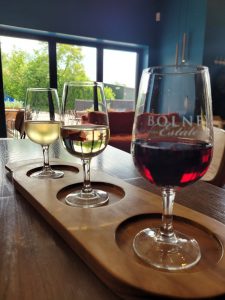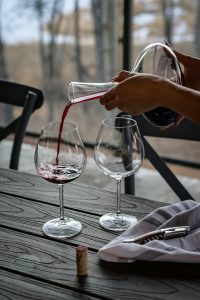Have you ever poured a glass of wine you loved at a winery, only to find it tastes completely different at home? You’re not alone!

Many wine lovers experience this moment of disappointment. You know what this is – that “Wait… what happened?” feeling when the same bottle just doesn’t taste as magical as it did when you tasted it at the winery.
But there’s a good reason for it. From lighting and temperature to your own mood and surroundings, a lot can change the way you perceive flavor. Let’s explore why wine can taste so different outside the tasting room. Plus I’ve got some tips about what you can do to make your next sip just as good as you remember.
So why does the wine tasting experience change? Here are some of the more common reasons for the difference in wine taste you may come across.
1. The Food You Ate While Wine Tasting Is Different
Wine and food are natural partners. A wine that sang when paired with that little piece of cheese at the winery may taste flatter or harsher when sipped alone at home. That’s because the fats, acids, and textures in food interact with wine on a chemical level.
💡 Tip: Try pairing your wine with a similar style of food to what you enjoyed at the winery. Even a simple cheese board can make a huge difference.
2. The Company You Keep (and Your Emotions) Matter
Wine is social and emotions play a big role in perception. When you’re tasting wine surrounded by friends, laughter, or beautiful scenery, your brain releases feel-good chemicals that can literally make wine taste better. On the flip side, tasting the same wine after a stressful day might dull your enjoyment.

💡 Tip: Pay attention to your setting. A relaxed mood enhances flavor perception more than you might think.
3. Your Mood Alters Your Perception
Closely tied to the previous point, your emotional state changes your brain chemistry — and your brain is where you actually “taste” wine. If you’re tired, distracted, or even too excited, the same bottle may taste completely different.
💡 Tip: Before opening that special bottle, take a breath. Set the mood, slow down, and let your senses catch up.
4. Scents in the Air Can Mask Wine Aromas
Because most of what we call “taste” is actually smell, the aromas around you can interfere with what you perceive in your glass. The scent of candles, cooking food, perfume, or even cleaning products can all distort the wine’s character.
💡 Tip: Avoid strong competing scents when tasting. Let your wine, not your air freshener or perfume, set the mood.
5. How Long the Wine Was Decanted (or Allowed to “Breathe”)
At a winery, bottles are often opened well in advance or decanted to let oxygen unlock aromas and soften tannins. In fact, often the wine you are tasting has been opened the day before. If you open a bottle at home and pour right away, you might be tasting a “closed” version of that same wine.
💡 Tip: Let red wines breathe for 15–30 minutes in a decanter, or even an hour for bigger styles. Swirling your glass also helps.

6. Temperature Makes a Big Difference
Temperature is one of the most overlooked aspects of wine enjoyment. Too cold and the flavors are muted; too warm and the alcohol overwhelms everything else. That perfect sip you had at the winery was probably served at just the right temperature.
💡 Tip: Aim for around 8–10°C (46–50°F) for whites and 15–18°C (59–65°F) for reds.
I’ve written a whole post about the “right” temperatures for wine. Read it here.
7. The Wine’s Vintage Might Not Be the Same
It’s easy to overlook this one! You may have tasted a 2020 vintage at the winery but bought the 2021. Even a single year can bring big changes; things such as weather, harvest timing, and winemaking choices all affect flavor. Wineries strive for consistency, but Mother Nature doesn’t always cooperate.

💡 Tip: Always check the vintage on the bottle. If it’s different, expect subtle (or not-so-subtle) variations.
Bringing Back the Winery Magic at Home
At the end of the day, all that really matters is if you enjoy the wine you are tasting right now. If that wine doesn’t taste the same as it did in the winery, change a few things and then enjoy it for what it is!
Here’s a quick summary of what you can do:
- Pair wine with food that complements it.
- Check your lighting, temperature, and scents.
- Create a relaxed mood and enjoy with good company.
- Give your wine time to open up.
If you’re curious about learning how to taste and evaluate wine more confidently, you have lots of options. One of them is taking a course from the Wine and Spirits Education Trust. Who knows what you’ll find?

Leave a Reply